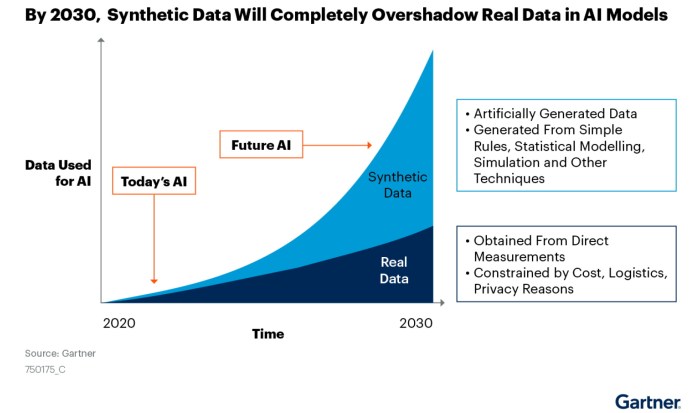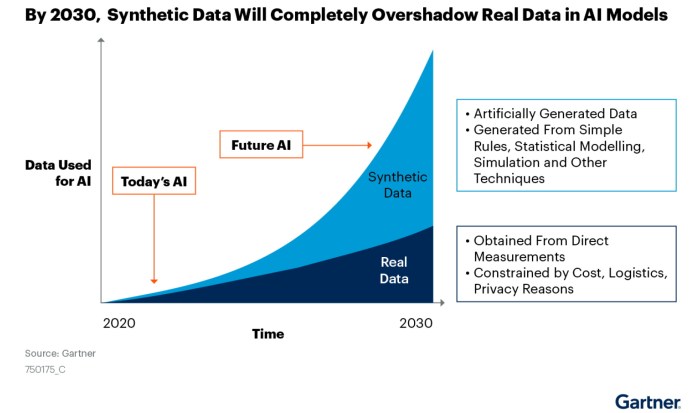Synthetic data safe low cost alternative data – Synthetic data: a safe, low-cost alternative to real data is revolutionizing how businesses operate. This innovative approach allows companies to generate artificial datasets that mimic real-world data without compromising sensitive information. Imagine a world where you can analyze customer behavior, test new products, and train machine learning models without ever needing to collect actual personal data.
It’s a game-changer for industries like healthcare, finance, and marketing, where privacy and security are paramount.
The potential benefits of synthetic data are vast. It offers a way to comply with strict privacy regulations while still unlocking valuable insights. Moreover, it can drastically reduce the time and cost associated with traditional data collection methods.
In a world increasingly concerned about data privacy, synthetic data emerges as a powerful tool for innovation and responsible data utilization.
Introduction to Synthetic Data
Synthetic data is artificial data created to mimic real-world data, designed to have similar statistical properties and characteristics but without containing any actual personal or sensitive information. It is generated using algorithms and statistical models that learn from existing real data, enabling the creation of realistic and representative datasets.
The primary purpose of synthetic data is to address privacy concerns associated with using real data while still maintaining the integrity and value of the information. It allows organizations to perform various data-driven tasks, such as testing, training machine learning models, and conducting simulations, without compromising the privacy of individuals.
Real-World Applications of Synthetic Data
Synthetic data finds its application in various real-world scenarios, offering valuable solutions for data-driven tasks. Here are some prominent examples:
- Healthcare: Synthetic patient data can be used to train machine learning models for disease prediction, diagnosis, and treatment recommendations, without exposing sensitive patient information.
- Financial Services: Synthetic financial data can be used to simulate market scenarios, test fraud detection algorithms, and develop risk management strategies.
- Marketing and Advertising: Synthetic customer data can be used to personalize marketing campaigns, target specific customer segments, and test advertising effectiveness.
- Research and Development: Synthetic data can be used to simulate complex systems, conduct scientific experiments, and analyze data without relying on real-world data.
Benefits of Using Synthetic Data
Synthetic data offers several advantages over using real data, making it an attractive alternative for various applications.
- Privacy Protection: Synthetic data protects the privacy of individuals by removing any personally identifiable information, ensuring compliance with data privacy regulations.
- Data Availability: Synthetic data can be generated in large quantities, addressing the challenge of limited real-world data availability, particularly for niche or sensitive domains.
- Flexibility and Control: Synthetic data allows for greater control over the data generation process, enabling customization of data characteristics and scenarios for specific use cases.
- Cost-Effectiveness: Generating synthetic data can be more cost-effective than collecting and cleaning real data, particularly for large datasets or complex data requirements.
Synthetic Data as a Safe Alternative
Synthetic data offers a safe and effective way to work with sensitive information without compromising privacy. It’s a powerful tool for innovation, allowing businesses and researchers to leverage data for various purposes without the ethical and legal complexities associated with real data.
Remember to click meta turns to reels and metaverse to recover from first ever revenue loss to understand more comprehensive aspects of the meta turns to reels and metaverse to recover from first ever revenue loss topic.
Protecting Sensitive Information
Synthetic data plays a crucial role in protecting sensitive information by creating artificial datasets that mimic the characteristics of real data while removing any personally identifiable information (PII). This means you can analyze and utilize data for various purposes without exposing the privacy of individuals.
For instance, a healthcare provider could use synthetic data to train a machine learning model to predict patient outcomes without compromising patient privacy. The model would be trained on a dataset that mirrors the real data but without any identifiable patient information.
Ethical Considerations of Using Synthetic Data
While synthetic data offers a powerful solution for privacy concerns, it’s crucial to consider the ethical implications of its use. One key aspect is ensuring that the synthetic data accurately represents the real data. If the synthetic data is not representative, it could lead to biased results or inaccurate conclusions.
Additionally, it’s important to ensure that the synthetic data is not used to discriminate against individuals or groups.
Compliance with Privacy Regulations
Synthetic data can be instrumental in complying with various privacy regulations, such as the General Data Protection Regulation (GDPR) and the California Consumer Privacy Act (CCPA). By creating synthetic data, organizations can comply with data minimization principles and reduce the risk of data breaches.
For example, a company could use synthetic data to conduct market research without collecting or storing any real customer data. This would allow the company to gain valuable insights while ensuring compliance with privacy regulations.
Cost-Effectiveness of Synthetic Data
Synthetic data, a powerful tool for data-driven decision-making, offers significant cost advantages over traditional data collection methods. By creating artificial datasets that mimic real-world data characteristics, synthetic data can significantly reduce the expenses associated with acquiring and preparing real data.
Cost Comparison: Real Data vs. Synthetic Data
The cost of collecting and preparing real data can be substantial, involving various expenses, including:
- Data Acquisition: Purchasing data from external sources, conducting surveys, or collecting data through web scraping can be expensive, especially for large datasets.
- Data Cleaning and Preparation: Cleaning and preparing real data for analysis is a time-consuming and resource-intensive process, requiring skilled personnel and specialized tools.
- Data Security and Compliance: Ensuring data privacy and complying with regulations like GDPR can involve significant costs for data storage, security measures, and legal expertise.
In contrast, generating synthetic data can be significantly more cost-effective. The cost of creating synthetic data typically involves:
- Software and Infrastructure: Investing in synthetic data generation tools and software, which can be a one-time cost, is often lower than the ongoing expenses associated with real data acquisition and maintenance.
- Computational Resources: Generating synthetic data requires computational power, but the cost is often lower than the costs associated with storing and processing large real datasets.
- Data Scientist Expertise: While skilled data scientists are needed for designing and generating synthetic data, their time and expertise are typically used more efficiently compared to cleaning and preparing real data.
Cost Savings with Synthetic Data
Using synthetic data can lead to substantial cost savings in various aspects of data-driven projects:
- Reduced Data Acquisition Costs: Synthetic data eliminates the need for expensive data collection efforts, allowing organizations to access large, diverse datasets without incurring the costs of purchasing or collecting real data.
- Simplified Data Preparation: Synthetic data is generated in a clean and structured format, reducing the need for extensive data cleaning and preparation processes, saving time and resources.
- Lower Data Storage and Management Costs: Synthetic datasets are typically smaller than real datasets, requiring less storage space and reducing the costs associated with data management.
- Reduced Data Security and Compliance Costs: Synthetic data can be generated with built-in privacy and security features, minimizing the risks and costs associated with data breaches and regulatory compliance.
Examples of Cost Reduction with Synthetic Data
- Financial Institutions: Synthetic data can be used to create realistic customer profiles for testing fraud detection models without using sensitive real data, reducing the costs associated with data privacy and compliance.
- Healthcare: Synthetic data can be used to simulate patient data for training medical AI models, eliminating the need for costly and time-consuming data collection from real patients.
- Retail: Synthetic data can be used to generate realistic customer purchase histories for testing marketing campaigns and optimizing product recommendations, reducing the costs associated with collecting and analyzing real customer data.
Types of Synthetic Data Generation Techniques: Synthetic Data Safe Low Cost Alternative Data
Generating synthetic data involves creating artificial datasets that mimic the characteristics and patterns of real data, while preserving privacy and confidentiality. Several techniques are employed to achieve this, each with its own strengths and limitations.
Generative Adversarial Networks (GANs)
GANs are a popular technique for generating synthetic data, especially for images and other complex data types. They consist of two neural networks: a generator and a discriminator. The generator learns to create realistic synthetic data, while the discriminator tries to distinguish between real and synthetic data.
Through a competitive process, the generator becomes increasingly adept at producing data that fools the discriminator.
GANs are particularly effective in generating high-quality images, videos, and audio, but can be computationally expensive and require extensive training data.
Variational Autoencoders (VAEs)
VAEs are another type of neural network-based technique that uses a probabilistic approach to generate synthetic data. They learn a latent representation of the data, which can be used to generate new data points that resemble the original distribution.
VAEs are less computationally demanding than GANs, but may produce less realistic data, especially for complex data types.
Probabilistic Graphical Models (PGMs)
PGMs are a class of statistical models that represent relationships between variables using graphs. They can be used to generate synthetic data by specifying the relationships between variables and then sampling from the model.
PGMs are particularly useful for generating data with complex dependencies, such as data that includes relationships between different features.
Rule-Based Methods, Synthetic data safe low cost alternative data
Rule-based methods rely on predefined rules or patterns to generate synthetic data. These rules can be derived from domain knowledge or statistical analysis of real data.
Rule-based methods are often used to generate data for specific scenarios or to ensure that the synthetic data meets certain requirements.
Data Transformation Techniques
These techniques involve manipulating real data to create synthetic data. For example, data can be shuffled, masked, or aggregated to create new datasets.
Data transformation techniques are often used to protect sensitive information while preserving the overall structure and patterns of the original data.
Real-World Use Cases of Synthetic Data

Synthetic data has emerged as a powerful tool for various industries, enabling them to overcome data-related challenges and unlock new opportunities. Its ability to generate realistic yet safe and privacy-preserving data has revolutionized how organizations approach data-driven decision-making.
Healthcare
Synthetic data has proven particularly valuable in the healthcare industry, where patient privacy is paramount.
- Developing and testing new medical treatments and devices:Synthetic patient data allows researchers to simulate real-world scenarios without compromising patient confidentiality. This enables them to train machine learning models to diagnose diseases, predict patient outcomes, and develop personalized treatment plans.
- Improving clinical trial design:Synthetic data can be used to create virtual patient populations that mimic the characteristics of real-world patient cohorts, facilitating more efficient and effective clinical trial design.
- Enhancing medical education:Synthetic patient records provide a safe and ethical way for medical students and professionals to practice their skills and learn from realistic case studies without accessing sensitive patient information.
Financial Services
The financial services industry relies heavily on data to make informed decisions. Synthetic data offers a solution to the challenges of data privacy and security, allowing for:
- Developing and testing fraud detection algorithms:Synthetic data can be used to create realistic scenarios of fraudulent transactions, enabling financial institutions to train and evaluate their fraud detection models effectively.
- Improving risk assessment models:By generating synthetic data that reflects various economic and financial conditions, institutions can test their risk models and assess their performance in different scenarios.
- Developing personalized financial products and services:Synthetic data allows for the creation of virtual customer profiles, enabling financial institutions to develop and test personalized financial products and services without compromising customer privacy.
Marketing and Advertising
Synthetic data plays a crucial role in enhancing marketing and advertising campaigns, particularly in:
- Targeting and personalization:Synthetic data allows for the creation of virtual customer profiles with realistic demographics, preferences, and behaviors, enabling more effective targeted advertising campaigns.
- Testing marketing campaigns:Synthetic data can be used to simulate different marketing scenarios and test the effectiveness of various campaigns before they are launched in the real world, optimizing campaign performance and reducing costs.
- Improving customer segmentation:Synthetic data can be used to create customer segments that are more representative of the real population, leading to more effective marketing strategies.
Autonomous Vehicles
Synthetic data has become essential in the development of autonomous vehicles, where:
- Training autonomous vehicle systems:Synthetic data is used to create virtual environments and scenarios that simulate real-world driving conditions, enabling the training of autonomous vehicle systems in a safe and controlled environment.
- Testing and validating autonomous vehicle algorithms:Synthetic data can be used to test and validate the performance of autonomous vehicle algorithms in various scenarios, including extreme weather conditions, heavy traffic, and unexpected events.
- Generating realistic driving scenarios:Synthetic data allows for the creation of diverse and realistic driving scenarios, including different road types, traffic patterns, and pedestrian behavior, providing valuable training data for autonomous vehicle systems.
Challenges and Future Directions
While synthetic data presents a compelling solution for various data-driven challenges, it’s crucial to acknowledge its limitations and explore avenues for improvement. Understanding these challenges is essential for realizing the full potential of synthetic data and addressing its limitations.
Limitations of Synthetic Data
Synthetic data generation techniques are constantly evolving, but current methods still face certain limitations.
- Accuracy and Realism:Generating data that accurately reflects the real-world distribution and relationships can be challenging. Synthetic data might not capture all the nuances and complexities present in real data, leading to potential inaccuracies in analysis and modeling.
- Data Complexity:Complex datasets with intricate relationships and dependencies can be difficult to synthesize accurately. Capturing the full spectrum of real-world data complexity in synthetic data requires sophisticated algorithms and extensive training data.
- Bias and Fairness:Synthetic data generation models can inherit biases from the training data. This can lead to biased results and unfair outcomes in downstream applications, particularly in sensitive areas like healthcare or finance.
- Interpretability:Understanding the mechanisms underlying synthetic data generation can be challenging. This lack of interpretability can hinder trust and limit the ability to validate the synthetic data’s quality.
Areas for Improvement in Synthetic Data Generation Techniques
Addressing the limitations of synthetic data requires continuous improvements in generation techniques.
- Enhanced Realism and Fidelity:Research efforts are focused on developing more sophisticated algorithms that can capture complex data relationships and generate synthetic data with higher realism and fidelity. This involves incorporating advanced statistical modeling techniques, deep learning models, and generative adversarial networks (GANs).
- Improved Bias Mitigation:Techniques are being developed to address bias in synthetic data generation. These methods involve incorporating fairness constraints into the training process, using de-biasing techniques, or developing bias-aware synthetic data generators.
- Increased Interpretability:Researchers are working on developing more transparent and interpretable synthetic data generation models. This involves techniques like model explainability, feature attribution, and visualization tools to enhance understanding of the synthetic data generation process.
- Scalability and Efficiency:Generating large volumes of synthetic data can be computationally expensive. Developing efficient and scalable algorithms is crucial for practical applications, especially in scenarios with massive datasets.
Future Potential of Synthetic Data
Synthetic data holds immense potential to revolutionize various fields.
- Healthcare:Synthetic patient data can be used for training machine learning models for disease prediction, drug discovery, and personalized medicine, while protecting patient privacy.
- Finance:Synthetic financial data can be used for fraud detection, risk assessment, and developing trading strategies without exposing sensitive customer information.
- Autonomous Vehicles:Synthetic data can be used to train self-driving car algorithms in various driving scenarios, reducing the need for real-world testing and improving safety.
- Social Sciences:Synthetic data can be used to study social phenomena, conduct simulations, and develop policies without compromising individual privacy.



